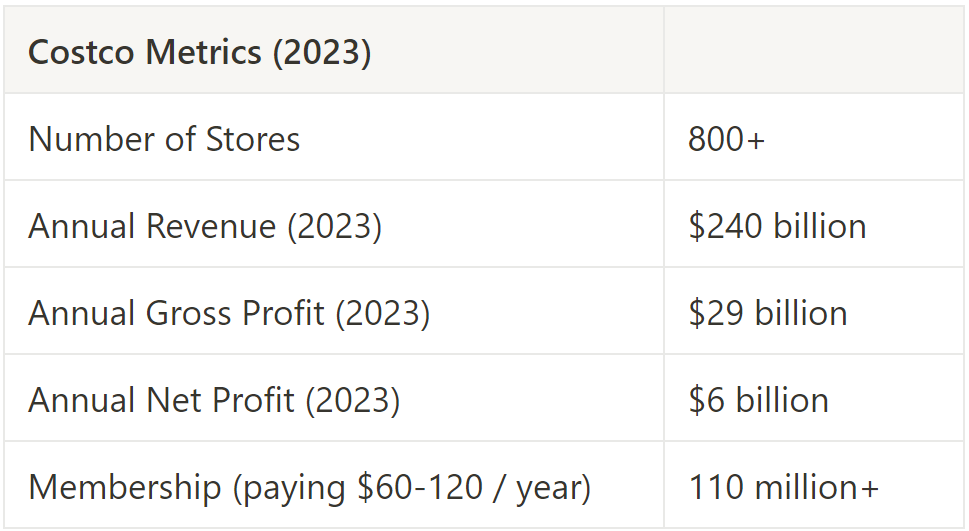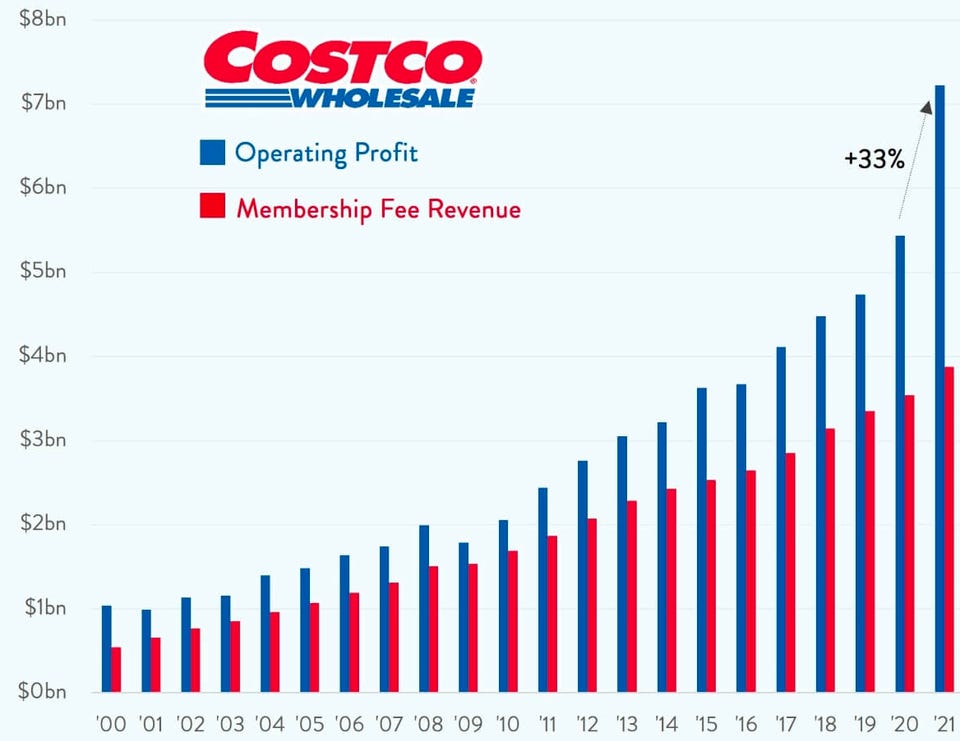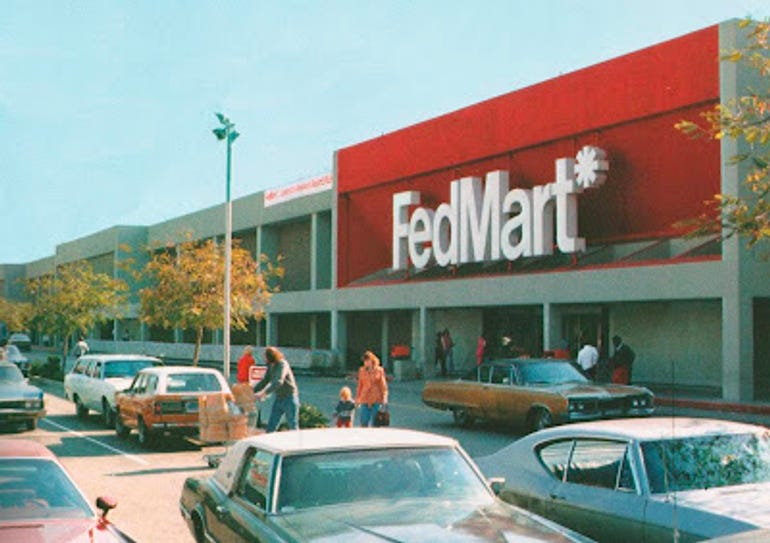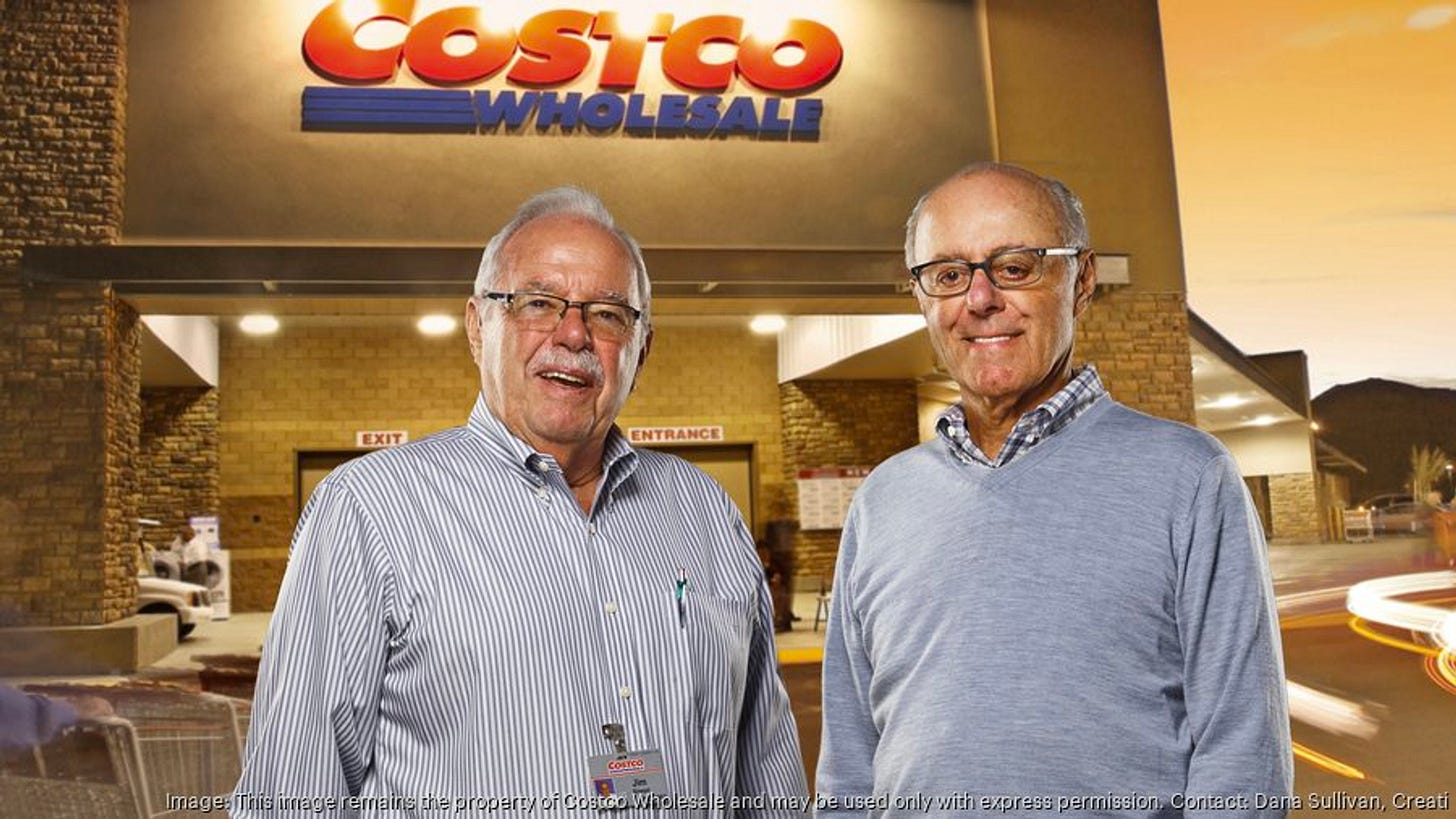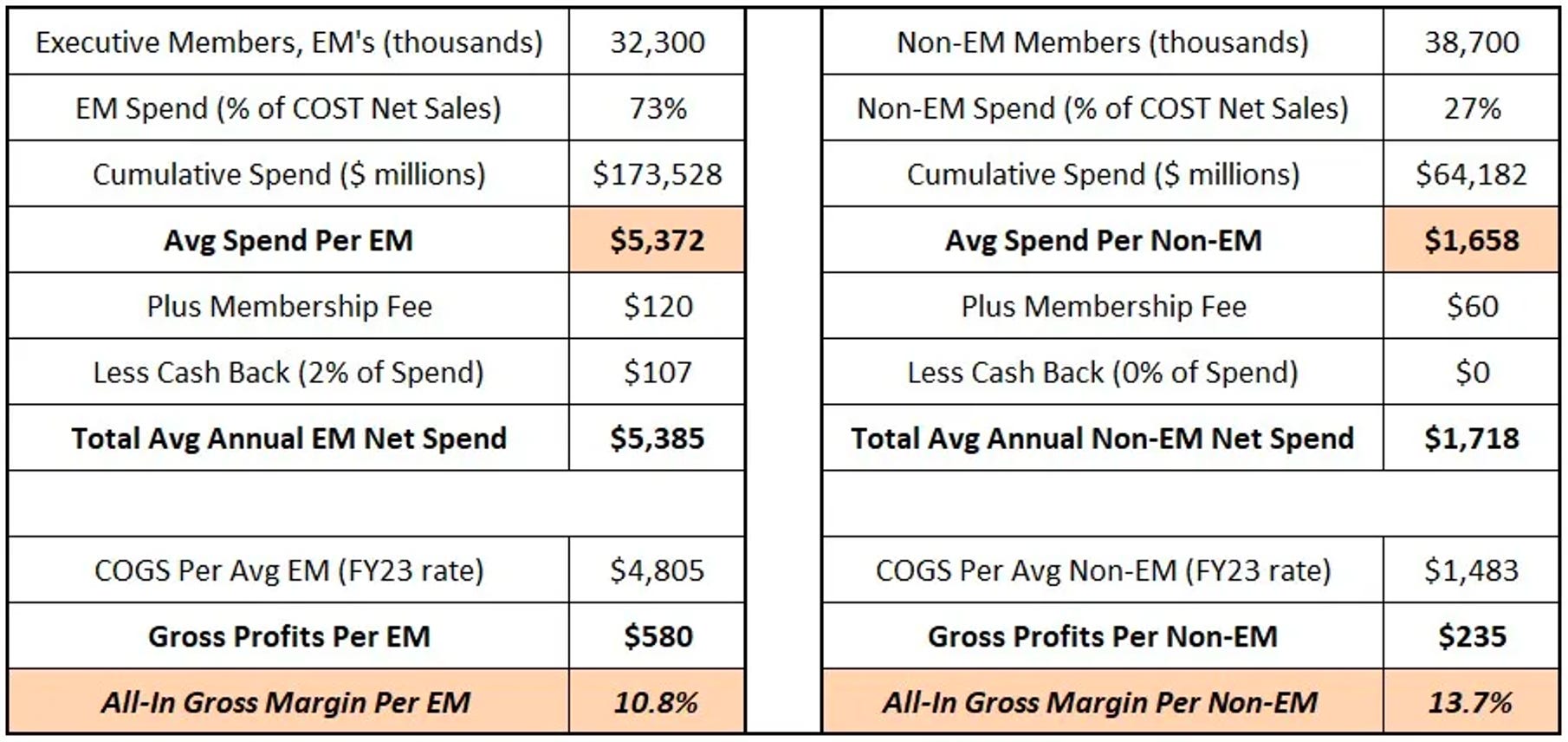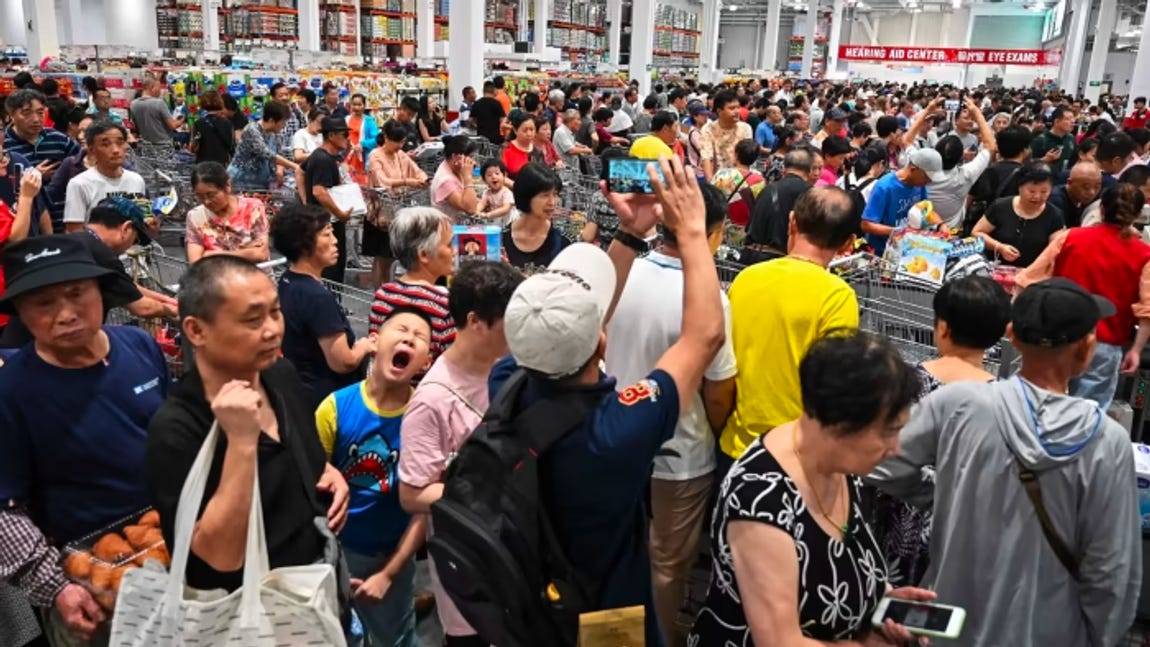Disclaimer - This primer is for inspirational & educational purposes only 💡
Its not investment advice. Figures are from public sources. Opinions are of the author, subject to change over time and may not be updated. Written by K.P. in Oct ‘23
Its not investment advice. Figures are from public sources. Opinions are of the author, subject to change over time and may not be updated. Written by K.P. in Oct ‘23
Contents:
1) Background
2) Founding story
3) The Model
1) Background
“There are two types of companies in this world; companies that work hard to charge their customers more and companies that work hard to charge their customers less”.
Costco is a retailer at heart, with the economics of a SaaS company.
wtf is Costco? 🤔
Costco is more than a leading global retailer with 800+ stores, $240bn+ in revenue and 110mm+ paying members…Its a business invention
On the surface - it operates a members-only, warehouse-style shopping experience. Known for its high-quality products at bargain prices. They sell everything; from simple packaged snacks, clothes & electronics to diamonds, car fuel & vacations.
Below the surface - it has invented a hybrid ‘membership-plus-retail’ model that superpowers its unit economics (relative to other retailers like Walmart). From the outside the numbers seem more like a SaaS business than a typical retailer.
This blended model enables Costco to deliver phenomenal value to its customers i.e.
(i) the highest quality products
(ii) at lowest prices possible, per unit
(iii) with stronger net profit & cash flow than a normal retailer
The model is almost antithetical - While most retailers try to maximise markups on products in the chase of profit, Costco keeps markups as low as possible (maintaining 10-14% vs other retailers’ ~50%). This enables them to drive up volume while passing savings to members
Additionally, Costco exhibits a maniacal obsession over customer experience, specifically with its careful product selection & down-to-earth, folksy values
Costco is rare economic phenomenon - making it obsession of Warren Buffet & Charlie Munger
😆 Warren Buffet’s joke about Charlie Mungers’ crazy obsession with Costco’s business:
2) Founding Story
🕰️ Blend of vision & quiet execution
Act 1 - FedMart
Sol Price is a lawyer in small town California in the early 1950’s
He is fascinated by FedCo (non-profit shop for ‘federal employees’ such as military veterans of WW2, offering subsidised prices)
He wanted to start a FedCo franchise for non-federal employees - but they refused
Instead, in 1954, he started FedMart in San Diego (clone of FedCo, but for-profit). He found a loophole allowing them to sell below ‘market price’ by offering a ~$2 annual membership
In their first year they did $3mm
Shortly thereafter, Sol Price hires a college student called Jim Sinegal, as a part-time bagger (who would later co-found and run Costco)
They go public in 1959, raising $2mm to expand, add stores and extend the offering (to selling medicines, petrol, cola etc)
1976, they sell a large stake in FedCo to a German real estate guy. But within a short time span, disagreements emerge & Sol Price is fired from his own company
Act 2 - Price Club
Undeterred, the next day they start Price Club to evolve the concept
This next avatar was designed as a warehouse-solution for business owners (for ex; owner of a grocery or clothes store). On one hand, suppliers would drop products off in the ‘warehouse’ & on the other hand, business owners could browse, buy & take items away immediately. This led to; (i) no waiting time for customers, (ii) less stocking time for employees, (iii) immediate payment for suppliers and (iv) quick cash flow for Price Club - a virtuous cycle
Slowly this opens to end-users, not just business owners
1982 they list on NASDAQ (+ Walmart copies Price Club with its own Sam’s Club)
Fun story 1 - Sam Walton of Walmart is caught by Price Club staff taking extensive notes on a tape recorder while browsing a store. Employees confiscate the recorder, only for Sol Price to find out and post it back to Sam. He even befriends Sam Walton, inviting him home for dinners, all while Sam was openly copying his concept. Sol Price did not care about competition.
Fun story 2 - Sol Price repeatedly encourages a friend, Bernard Marcus, to start the Price Club for furniture and home fittings. Bernard does so… it becomes Home Depot.
Act 3 - Costco
1983 - Jeff Brotman wants to open a franchise of Price Club in Seattle, but Sol Price refuses. Instead he hires Jim Sinegal (Sol Price’s protege) & they start Costco with $7.5mm, selling 50% of the company. They hire 8 people in their 50’s and evolve the concept again
It is essentially based on the same hybrid membership-retail model in warehouse-style experience, but with better execution and more acute obsession over product selection
Costco hits $1bn revenue in 3 years of starting and $3bn in 6 years of starting
They go public in 1985
In June 1993, Costco and Price Club merge in a balanced partnership (52% for Costco and 48% for Price Club) creating a combined 200 stores & $16bn market cap. Despite Costco’s relative dominance, the strong relationship between Sol Price and Jim Sinegal created an unusual merger of equals with similar values (’business-cousins’).
In the late 1990’s Costco starts an in-house brand called Kirkland Signature (that would eventually become as big as Nike)
The company accelerates its global expansion adding stores in Mexico, the United Kingdom, and Japan in the early 1990s, followed by South Korea, Taiwan, France, Australia and China in the 2000’s
Over the subsequent 25 years, Costco fine-tuned its model, while maintaining its strong values to become what we see today
3) MODEL
🏛️ Costco has invented a unique model for retail, supported by 3 pillars: (a) Membership, (b) Product selection & (c) In-store experience. Below, we expand on each pillar, followed by the effect it has on Costco’s economics
(a) MEMBERSHIP+RETAIL HYBRID
Cause:
(i) Membership - people pay $60-$120, annually, to access the store
(ii) Combined with high-volume, low-margin retail margins
Membership tiers
Effect:
Enabler, not just profit generator - total revenue from membership fees drops straight to the bottom line (~$4bn, 100% margin profit). This robust, recurring profit stream mimics a SaaS company, more than a retailer. It represents ~70% of the operating income, with remaining 30% coming from retail margins (on total income of ~$6bn, from ~$240bn of revenue). However, on a deeper level, the steady membership fees empowers Costco to offer razor-thin markups and pass those savings on to customers. Overall, it creates less reliance on the typical retail margins to sustain ops & drive growth.
Working capital generator - membership fees generate phenomenal, upfront working capital for the running of the business (~$4bn of cash pouring in at the start of the year!)
Valuation multiples - the predictability, profitability and knock-on benefits of the membership model supports a higher valuation multiple, relative to other retailers (for example Costco trades at 22x one-year forward EV/EBITDA, vs Walmart’s 13x, Target’s 9x and Kroger’s 8x)
‘Endowment effect’ - paying for membership upfront seems to encourage customers to return to the store as much as possible to maximise their return on the investment i.e. “make most of the deal”. This drives visits (frequency) and spend per trip (AOV). Specifically, higher tier members (Executive Members aka ‘EM’) seem to spend ~4x more than regular (Non-EM) members.
Filters for target customers - membership model helps Costco filter for more affluent customers (who are willing to pay upfront for fee + buy in bulk). Costco customers’ average household income is ~$120,000 vs Walmart’s ~$80,000. They offer the lowest prices, but to wealthiest customers in America.
Reduces Shrinkage - Membership access reduces theft because (i) it filters for serious, non-criminal shoppers, (ii) people don’t want to lose membership & (iii) high volume packs are harder to steal.
Trust & community - membership community seems to install the belief that Costco will offer the absolute best price on everything and they won’t play the excessive markup game
Efficient Advertising Spend - a captive user base reduces Costco's dependency on advertising spend, accounting for < 0.1% of its revenue (vs Walmart >0.4%).
(b) PRODUCT SELECTION
Cause:
(i) Low SKUs count
only ~4,000 SKUs are stocked at once in a store (vs Walmart’s 200,000+), out of which 25% are “Treasure Hunt” items i.e. temporarily available
(ii) Strict rule of 12% markup on products from suppliers
with an absolute max ceiling of 14%, vs other retailers who function on a minimum markup of 25%, regularly extending to 100%.
Jim Senegal believes margins are like heroin - “if you start taking 25%, you will want more next time”.
(iii) Vertical integration (i.e. Private labels) for select categories
Costco will only backward integrate for categories that they believe are under-served by existing suppliers (or ridden with inflated margins), making it worth the increased overheads
Ex. 1 Kirkland Signature - As mentioned, this premium private label generates more revenue than Nike today (~$55bn+ vs ~$52bn). But its not a typical ‘private label’. Instead of being based on one product category **(such as staples or snacks or sports clothes or kitchenware etc), Kirkland Signature stretches across categories, from clothing to food to alcohol to home decor and more. It stands for highest, reliable quality, irrespective of category.
Ex. 2 Chickens - Costco is famous for its live food, such as their Rotisserie chickens & hot-dogs, which are both vertically integrated. The high in-store demand for chicken combined with the industry’s concentrated supply chain (only ~5 large suppliers), convinced Costco to own & operate a facility in order to provide the best quality-price ratio (vs buying outside). Today, they sell 500mm chickens per year (more than population of USA + Canada), of which 130mm are Rotisserie.

Kirkland Signature range of products; pet food, beauty, vitamins, clothing, luggage, office stationary & much more 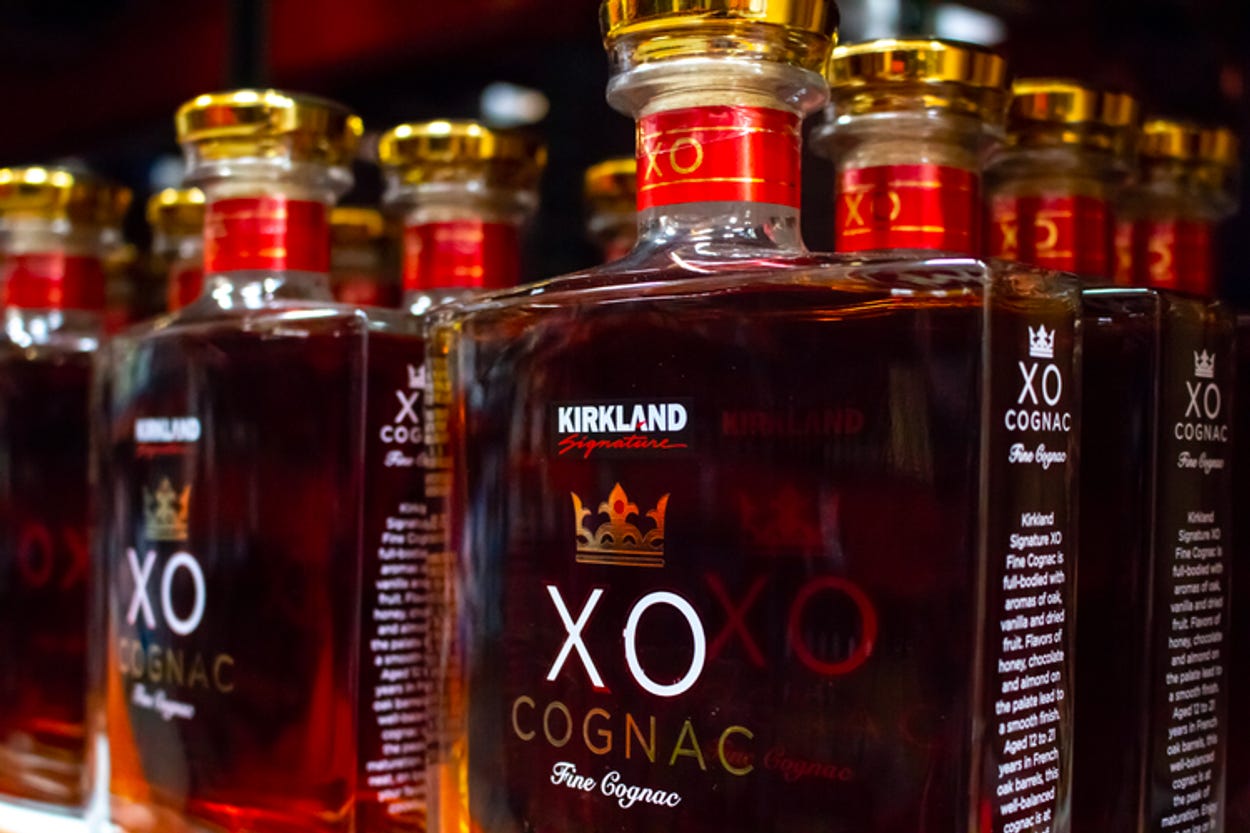
Kirkland Signature’s range extends to premium alcohol. Today Costco is the USA’s largest wine retailer Effect:
Positive supplier relationships - Fewer SKUs enables Costco to build long-term, productive partnerships with its suppliers. While this may increase Costco’s dependency on fewer suppliers, it enables them to work very closely on product development; adapting to trends, seasonality & commodity fluctuations. While most retailers such as Walmart are known to extract value from suppliers (squeezing them as much as possible), Costco is known to add value and help them succeed (one of the five Codes of Ethics is “Respect our suppliers”).
Pass value on to customers (not take) - Fixed, razor-thin markups enable Costco to provide highest quality products at the lowest prices, per unit. For every $1 the supplier reduces its price, Costco can pass that benefit to members. While most companies try find ways to take more margin for themselves, Costco constantly searches for ways to pass value to its members
Inventory turnover & cash conversion cycle - Low SKU count + good supplier relationships enables Costco to arrange payment terms in which inventory turns faster than the bills are due (within 30 days of receiving them). Costco turns inventory at least 12x per year vs Walmart’s 8x. As a result Costco has $0 locked in inventory, producing a negative cash conversion cycle with vendors financing operations (but in a non predatory manner)
(c) IN-STORE EXPERIENCE
Cause:
(i) warehouse-style layout & shopping experience
no back room, fancy shelving or displays + entirely guided flow
Effect:
Functional discovery - Guided layout (like Ikea) creates an entertaining tour experience, optimised to help customers stock the entire house (not forget anything)
Impulse purchases & repeat visits - At any given time, 25% of a store is filled with ‘Treasure Hunt’ items (only temporarily available). This seems to (i) create a sense of urgency to visit (ii) enhance the discovery experience and (iii) drive virality outside the store (YouTube & TikTok are flooded with Costco bargain hunters).
High sales / sq ft - the warehouse-style layout helps Costco minimise wasted space (no separate backroom or stocking area), ensuring every part used for selling. This helps it generate one of the highest sales / sq ft among retailers; $1,800 vs Walmart’s $600). Only luxury retailers seem to generate higher numbers, such as Tiffany at $3,000 (selling jewellery) and Apple at $5,500 (gold standard)
Logistics & operational simplicity - Costco’s warehouse-style shopping layout simplifies logistics, distribution and backend management of running a huge store. Suppliers directly stock in one part of the store, requiring minimal unpacking, movement or preparation by staff (no adjusting labels, careful shelf arrangements or changing displays). This reduces employee cost & overheads, driving efficiency.
Revenue per Employee - As a result, Costco's employee count is lower than other similarly sized retailers (~300,000 employees to generate ~$240bn revenue vs Walmart’s ~2mm to generate ~$600bn and Amazon’s 1mm+ to generate ~$530bn). This results in a notably higher revenue per employee ($800k per employee vs Walmart’s $300k and Amazon’s $530k). This is despite Costco paying one of the highest hourly wages in retail, averaging ~$26 per hour vs Walmart's ~$18 per hour.
CORE VALUES - THREAD HOLDING IT TOGETHER 🧬
Costco adheres by a strong set of values, that seem vague, but actually drive the business.
🗣️ ”Culture isn’t the most important thing — it’s the only thing”
- Jim Sinegal, on the importance of culture
Evidence:
“Focus inwards” to look at everything from members’ point of view - creates policies that exceed expectations
such as the ‘no-questions-asked’ refund policy, that lasts forever. The exception is electronics, with a refund policy of 90 days. For reference though, Apple provides only 2 weeks refund policy, if at all
Costco promote mostly from within (specially for the higher roles). They don’t use fancy, executive hiring agencies or hire the typical Harvard/MBA/McKinsey type, despite its $200bn+ market cap. Most of the executive team has been at Costco for 30+ years
Most members of the executive & senior management team don’t have public profiles or take interviews. For example Craig Jelineks is listed as an EVP at Costco on Linkedin, despite being global CEO for the past decade. They pay little attention to what other people think
Costco has never conducted layoffs…even after the Price Club-Costco merger nor Covid pandemic
“Every cent matters” philosophy - Internally, employees are encouraged to communicate in cents, not dollars. This seems to drive a frugal customer-perspective. For example, while communicating internally, instead of saying “it costs $3.98”, employees would say “it costs ¢180.98”
They do not care about competition, will not try out-advertise anyone
🧑🤝🧑 “No one was going to be able to say we’re making money off the backs of our employees, because we were going to pay the highest wages in all of retail…. Seventy cents of every $ spent by Costco goes to employee wages. And the company has a 7% turnover rate, compared to 60-70% at other retailers”
-Jim Sinegal
😲 Costco was the inspiration for Amazon’s values & specifically the Prime membership model. Blurb below describes an encounter between Jeff Bezos and Jim Sinegal:
“At the time—this is 2001—Amazon stock was in the dumps. They were under pressure from Wall Street. Jeff and the organisation were embarking on a campaign of raising prices on amazon.com to get profitable. They just started rolling out. It was super important.
Jeff has this coffee with Jim. Jim explains this philosophy to Jeff. Jeff comes back to Amazon HQ the next day.
He's like, “I'm reversing the policy” and shares Jim’s insight - That there are two types of companies in this world, companies that work hard to charge their customers more and companies that work hard to charge their customers less.
He says “Henceforth, as of today, Amazon is a company that works hard to charge its customers less”
And that is directly from Jim Sinegal.”
Acquired Podcast (S13, E2: Costco), referring to The Everything Store by Brad Stone
Next - what would ‘Costco of Health’ be like 🤔 🤷♂️ ?
Other Primer - LVMH: The biz of luxury
Sources
Special Mention! - Acquired Podcast S13, E2: Costco (https://www.acquired.fm/episodes/costco)
https://mitsloan.mit.edu/ideas-made-to-matter/how-costcos-obsession-culture-drove-success
https://seekingalpha.com/article/4569346-the-economics-of-costco-one-square-foot-at-a-time
https://costco-business-report-courtneyt.weebly.com/the-history-of-costco---a-timeline.html
https://panmore.com/costco-wholesale-organizational-culture-characteristics
https://medium.com/@charles.liong2020/the-economics-of-how-costco-is-beating-amazon-ca41903c3dc2
https://thirdbridge.com/transcripts/costco-membership-trends-new-unit-growth-outlook/
https://www.linkedin.com/pulse/costco-approach-key-lessons-people-management-bendoraityte-/
https://s201.q4cdn.com/287523651/files/doc_financials/2022/ar/Costco-2022-Annual-Report.pdf
https://www.directorsandboards.com/articles/singlebusiness-about-more-making-money
https://www.eaglepointcap.com/blog/costco-wonderful-business-expense-stock
https://www.fool.com/investing/general/2013/07/31/an-interview-with-jim-sinegal-of-costco.aspx
https://25iq.com/2014/05/24/a-dozen-things-ive-learned-from-james-sinegal/
http://mastersinvest.com/newblog/2019/7/5/learning-from-costcos-jim-sinegal
https://digitalcollections.lib.washington.edu/digital/collection/reports/id/44259
https://businesschronicler.com/business-history/costco-business-history/
Costco is THE place for inexpensive dining | The Seattle Times
https://wineeconomist.com/2007/08/22/costco-and-global-wine/
https://www.cascade.app/studies/how-costcos-business-model-resulted-in-success




